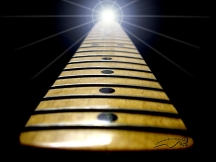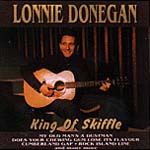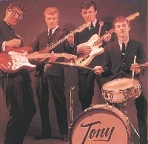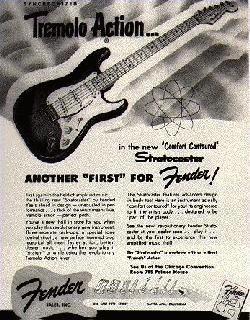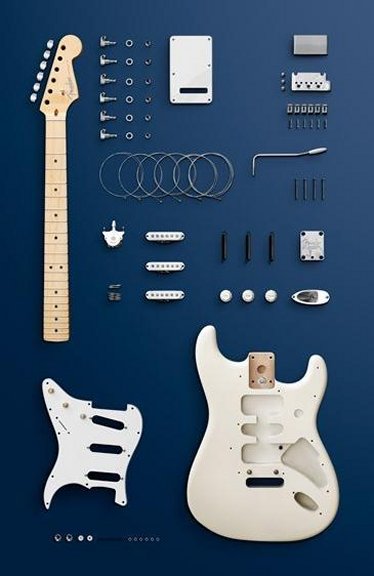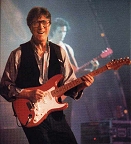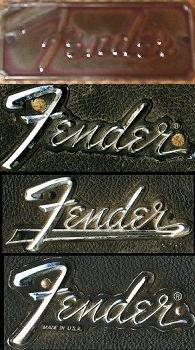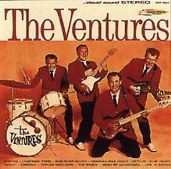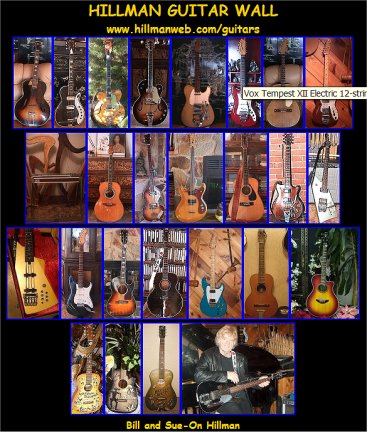Strat Tips
from Stratocaster
Appreciation Page
Pickup Height
The strat is notoriously temperamental with regard to pickup height
settings. If set too far from the strings, the sound will be weak and the
buzz intolerably loud. If set too close to the strings, the magnetic pole-pieces
will interfere with the vibration of higher notes, causing a distortion
of pitch. In addition, many people underestimate the influence which pickup
height and balance has on your tone. I have developed the following procedure
for the correct adjustment of strat pickup heights (this is intended for
traditional alnico magnet pickups-other types can usually be set closer
to the strings)
1. Set the bridge pickup 3 to 2.5 mm's from the pole piece to the bottom
of the string on BOTH the bass and treble sides of the pickup. (Some people
like to slant the pickup so that the treble side is much closer to
the strings, but if you want your head to remain ON your shoulders, I advise
against it) Now play some chords across all six strings on various places
on the neck. Listen carefully to the balance between the bass and treble
strings. If the bass strings are noticably louder than the treble or vice-versa,
raise or lower the appropriate side until a nice balance between high and
low strings is achived.
2. Now that the bridge pickup is set, its time to deal with the middle
pickup. Compare the output of the
middle pickup with that of the bridge and raise or lower it until the
output is the same. Again adjust the
pickup until a balance between the high and low strings is achieved.
3. Now the neck pickup. Much the same as points 1 and 2-get the output
the same as the middle pickup, can adjust for correct string balance.
Hopefully you will now have all the expected strat sounds at your disposal.
Also, if you want to increase
the 'quackiness' of the in-between tones AND/OR you rarely use the
middle pickup, screw it down low
and you will achieve the desired effect. Tremolo setup-floating or
clamped?
FLOATING: I'd Just like to say before this section, that you
should BEWARE when messing with the
tremolo set-up on a strat. Despite what I say below, NOT all strats
will benefit from having the tremolo
set flat to the body. In fact, this can actually make the tone rather
harsh and tinny on some strats. It has a lot to do with the way that the
tremolo cavity adds a certain resonance to the tone, and the trem set to
float can enhance this effect, giving a springier, more lively tone. Adding
springs and clamping down the trem can in some cases kill this. This
seems to vary widely from one strat to another, so some may be fine with
either trem set-up, others might suffer if you alter the set-up. The chances
are that your strat's tremolo is already set this way, so as to offer both
up and down pitch-control. If it is not, you can set it to do so like this:
1. Carefully remove the tremolo backplate on the back of your strat.
2. Observe how many springs are installed in the cavity-if there are
5, remove the 2nd and 4th ones, if
there are less than 3, don't remove any more. Now tune to pitch and
check if your tremolo now floats. If so, go to point 3. If not, you will
now need to adjust the tremolo claw-that thing which the wire is soldered
onto. Turn the screws which go into the body of the guitar counter-clockwise
until the claw has moved out a few mm's. Now tune to pitch and check
if the trem is now floating. If it is not, just continue adjusting until
it does, making sure you are tuned to pitch.
3. When at last your trem is floating, you need to set the tip up angle-the
distance between the end of the tremolo and the top side of the body. The
gap should be around 3mm. To set this, adjust the tremolo law, tightening
the screws if the gap is more than 3mm, loosening them if its less than
3mm.
4. Now replace the backplate, tune to pitch and enjoy your new-found
pitch shifting abilites.
CLAMPED: This is advisable if you don't use or like the trem
as it will give you a bit more sustain and
the ability to bend strings without the other ones dropping in pitch.
1. Remove the backplate and observe how many springs are installed in
the cavity. If there are 3 or less,
add more until all 5 are installed AND/OR Turn the tremolo claw screw
clockwise until the trem sits flat
to the body at concert pitch. Personally I prefer the adding-springs
method, as you only have to remove
them again if you want to have a floating trem.
2. Now replace the backplate and enjoy that tad more depth and sustain.
Tremolo tuning tips
There are many supposed 'methods' to stop the standard
strat trem from going out of tune, but in my
experince the following things are very helpful. First of all, make
sure that the nut is well cut and clean.
Next check that the string tree(s) behind the nut are not set too low,
thus giving a severe break angle
behind the nut. If they are raised so that the break angle is quite
gradual, then the tuning will be less likely to go out when you use the
trem. One last thing, which has always worked for me, although I don't
really know why, is the set-up of the springs in the tremolo cavity. Take
a look at the diagram to see what I mean. Using 'my set-up' where you attach
the springs to the inside 3 notches on the tremolo claw seems to improve
the tuning.
Counteracting that Annoying Buzz
You can reduce the buzz that single coil pickups
are prone to by screening the internal cavities with
adhesive backed aluminium tape. I have not done this myself, but if
you have the confidence and soldering skills, you could give it a shot.
1. You need to remove the scratchplate and position it so that you can
work at the cavitiy easily.
2. Now cut the aluminium tape into sections that will cover the entire
surfaces of the cavity, making sure
there are no gaps left anywhere, and that all separate
pieces of tape overlap.
3. Earth it all by placing a few centimetres of abare wire underneath
a section of tape and covering it
FIRMLY for a good connection. Solder the wire from the tape to a pot
to complete the circuit. A longer piece of wire is best so that you don't
have to desolder it if you remove the scratchplate. The noise should now
be signifigantly reduced, making your strat much more suitable for high-gain
applications.
Why can't I get a really heavy distortion sound?
Speaking of high gain applications, I have found many people go
out and buy a strat, or a strat type guitar and a distortion pedal, then
go home and wonder why they cannot achieve a really cool and heavy sounding
distortion such a la Nirvana or the Smasing Pumpkins. I believe (many may
disagree) that the most important factor in achieving a heavy distortion
is the pickup output. Of course a good pedal or amp will aid this process,
but it eventually comes down to needing a hot pickup to drive distortion.
Hot rail type pickups are good because they fit into the standard stratocaster
routing, and don't tend to get boomy like some full size humbuckers can.
Below is the Seymour Duncan diagram for wiring one of their hot rails pickups
in plain full humbucking mode.
Kent Armstrong hot rails can be wired as follows: There should
be five wires-red,green,black and white and a thick unshielded earth wire.
To wire it up as a full output humbucker and nothing else you should do
as follows: Solder together the black and white wires and insulate them.
Solder both the thick earth wire and the green wire to the volume pot (ground)
finally, solder the red wire to the selector switch.
I can't speak for any other brands, and I am not going
to get into the complications of coil tapping or
anything else. If you want to try this stuff get in touch with somebody
who knows about pickups. This is
a good mod if you want to get a really hot overdrive. It does eliminate
the bridge/middle sound however, but you can't have everything without
doing some more extensive wiring. Consider this if you have ever wondered
how Kurt Cobain got a really heavy distortion from Fenders. I think that
this mod on a good Strat is far better than the Jagstang model or the like.
The Strat, unlike some more eccentric Fender designs has decent sustain
and is well designed. I am not putting down Jaguars, Mustangs etc. I'd
own them all if I could, but the Strat is just a foolproof design.
Help!!! My Strat isn't working any more!
If you are unfortunate enough to find that one day
your Strat just is not working any more, and the
problem is a loose connection or wiring fault, then it is often useful
to have a reference source showing
how a Strat should be wired. Here is the Seyour Duncan diagram for
the 'standard' way to wire a strat, that is with 3 single coil pickups,
switch, volume pot and tone pot for neck and middle pickups. If your wiring
set-up is at all different from this, then the diagram may well be of little
use.
Always remember that there are many things that can go wrong apart from
simply a wire coming loose. In cases like this, where all the connections
are correct, you are always better to take the guitar to a good tech, who
will be able to tell you what exactly is wrong. |


.
.
Since its official debut in early 1954 the Fender Stratocaster has proven to be one of the most successful, most influential and most cloned electric guitars ever manufactured. This blue Strat was another of Sue-Onís surprise Xmas gifts and it made our first Brandon Christmas away from our country home a memorable one. One of my first guitar heroes was Hank Marvin of Englandís Shadows. I have always been intrigued by his red Strat, but since Sue-On knows that blue is my favourite colour, blue is what I got.
